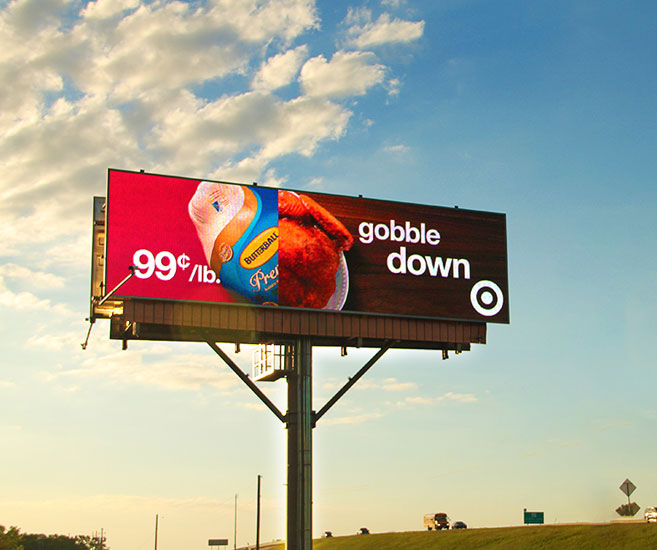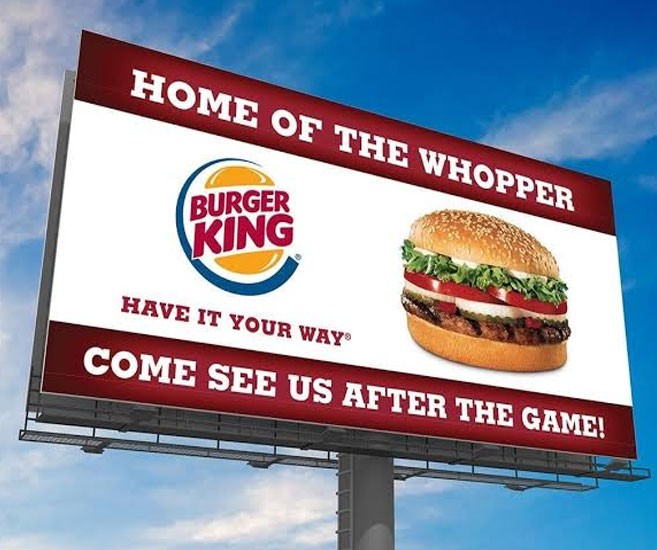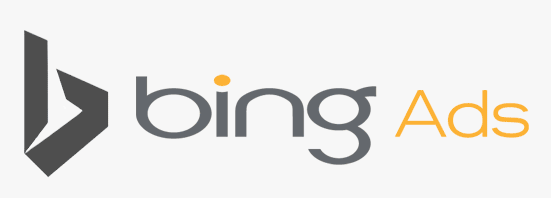

A billboard (also called a hoarding in the UK and many other parts of the world) is a large outdoor advertising structure (a billing board), typically found in high-traffic areas such as alongside busy roads. Billboards present large advertisements to passing pedestrians and drivers. Typically showing large, ostensibly witty slogans, and distinctive visuals, billboards are highly visible in the top designated market areas.
The largest standard-size billboards, known as Bulletins, are located primarily on major highways, expressways or principal arterials, and command high-density consumer exposure (mostly to vehicular traffic). Bulletins afford greatest visibility due not only to their size, but because they allow creative "Customizing" through extensions and embellishments.
Posters are the other common form of billboard advertising, located mostly along primary and secondary arterial roads. Posters are a smaller format than bulletins and are viewed principally by residents and commuter traffic, with some pedestrian exposure.
Billboard Facts:
The largest size of billboard available in any campaign is known as the "bulletin," but billboard sizes can vary greatly depending on location. However, the typical size of an advertising billboard is 14 feet high by 48 feet wide.
In the past, billboards were created using sections of paper posted together to form one image. Nowadays, digital printing on vinyl material allows the entire image to be printed on one sheet, and can be erected very quickly and easily.
The typical length of time for a billboard buy is 12 weeks. For this reason, it's important that billboards have content that is somewhat evergreen. Billboards are the ideal place for long-term messaging, but anything more reactive should go somewhere else.
Digital billboards allow creative executions that can be personalized, or swapped out with other creative ads. Sometimes, clients can choose to timeshare their ads with other companies, with the creative swapping out every few minutes.
Billboards are part of the OOH marketing mix, which stands for Out Of Home.
You only have a few seconds for someone to glance up at a billboard, so their size is a huge advantage. Large, bright, eye-catching graphics with one key message is the best route – it will leave people with a lasting impression in their mind.
Ads on billboards are free to passers by - they don't have to buy a newspaper or a cinema ticket in order to view your message.
With more commuters on the roads than ever before, billboard advertising allows you to reach more people faster and cheaper than any other mass marketing media.
With billboards you have a guaranteed audience. As your message gets repeated views it becomes more ingrained in their memory, they will remember it more and will come to find you.
Billboard advertising is the only media where the advertiser has full control of the ad space. The ad has constant exposure – no other media allows your message to be displayed 24 hours a day, 7 days a week.
Outdoor advertising on the whole is constantly evolving - media advertisers are working closely with brands to incorporate digital, social media and interactive strategies to increase consumer engagement.




